WHO WAS SAINT JOAN OF ARC?
- Published in St. Joan de Arc
Who was St. Joan of Arc?
 A Devout Girl
A Devout Girl
Saint Joan of Arc was born in a small town in France named Domremy, in the year 1412. As a child, she manifested a profound piety. She enjoyed visiting the church and other places associated with saints, as well as caring for the sick and giving alms to the poor. She often went on pilgrimage to the Shrine of Our Lady of Bermont, to whom she was especially devoted. Her parish priest claimed to “have no parishioner as good as she was.” Her parents raised her in the faith, with a special devotion to the Name of Jesus.
The “Voices”
Joan first started hearing her “voices” at the age of 13, in her father’s garden, at the hour of the Angelus. The first voice she heard was that of Saint Michael the Archangel, who informed her of her mission. Interestingly enough, several years later, during her trial she was interrogated regarding the message from the first apparition. Her words were: “First of all, he told me to be a good girl and that God would assist me.” Later on, reference was made to her future mission. Perhaps this is a lesson to us that the most important is not what God will ask of me in the future, but what He is asking of me now.
Two Missions
With the words of the angel, Joan clearly understands her missions. Her earthly mission is that of crowning the King of France and her supernatural mission, that of restoring the Kingdom of France to its true King and Lord, Jesus Christ.
For God Alone
The name her voices would give her was “La Pucelle” (maiden). St. Joan’s safeguard of her virginity and purity is one of the most outstanding characteristics of her life. She never lost her virginity, even in the midst of a war and surrounded by 10,000 men. In the trial, she declares: “The first time I heard the voice, I consecrated my virginity to God.” Thus, the fact that she had completely consecrated herself to God in virginity is not mere conjecture, but rather something Joan herself affirmed. The voices called her, “Joan, la Pucelle, daughter of God, daughter of an immense heart.” Her purity inspired all and the men who accompanied her bore witness to her profound goodness. Jean Coulon testifies: “Being with her was a great consolation.”
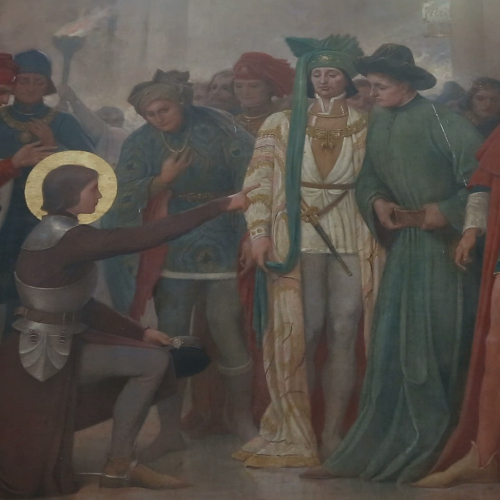 “You are he and none other…”
“You are he and none other…”
Five years passed between the first apparition and the appointed time for acting. She was told to reach Charles the Dauphin, who doubted his own legitimacy as heir to the French crown. But how? Her uncle providentially asked her to accompany him to Vaucouleurs, where she met with Sir Robert de Baudricourt, with whom she had to speak in order to reach the Dauphin. He agreed to have her escorted to the King’s Palace in Chinon. Upon hearing of her arrival, the King put her to the test and hid among the crowd. However, she discovered him and kneeling before him said, “In the name of God, gracious Prince, you are he and none other here present.”
She had a private audience with the King in which she revealed certain things he carried in his heart, giving him the necessary proof of her authenticity.
The First Trial – Poitiers
The King placed her veracity to the test, sending her to appear in Poitiers before a tribunal of theologians and canon lawyers led by the Archbishop of Reims, Regnault de Chartres. In the presence of the tribunal, Pierre de Versailles made it clear that she was there to respond to their questions, to which she replied, “I know you have all come to interrogate me. That being said, I neither know A nor B. All I know is that I come on behalf of the King of Heaven to lay siege to Orleans and to lead the Dauphin to Reims, that he may be crowned and consecrated there.”
Although the complete text of the tribunal’s conclusion is lost, the fragments that have reached us speak for themselves: “We find nothing worthy of reproach in her – only humility, goodness, virginity, devotion, honesty, and simplicity. […] The King must not prevent her from journeying to Orleans, for fearing or rejecting her would mean rejecting the Holy Spirit and would render us unworthy of God’s assistance.”
The Liberation of Orleans
Joan amazed many with her military skill, which she demonstrated throughout the battles as she reclaimed territories for France. One eyewitness, Margarita La Touroulde, recounts: “As far as I could observe, Joan was very simple and ignorant and knew nothing whatsoever, except things related to war… Concerning weaponry, I saw her ride a horse and carry a lance as well as the best of soldiers, and this amazed everyone.”
Orleans was under siege by the English. She became the commanding officer for 10,000 men, all of whom trusted and believed in her. Several miracles occurred, enabling them to enter and liberate Orleans. Finally, on May 8, feast of St. Michael, the English lifted the siege and the city was freed. Following this victory, many soldiers believed in Joan and their hope grew.
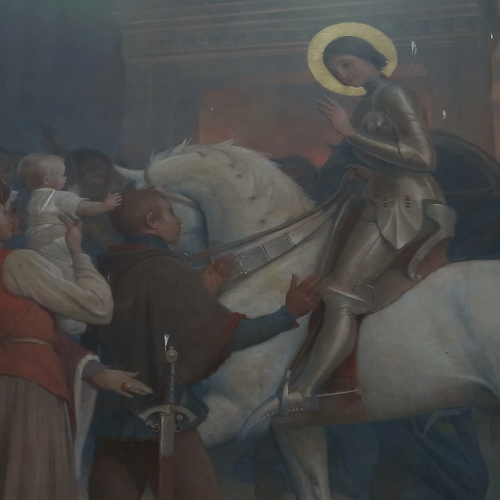 I Love My Banner Much More
I Love My Banner Much More
History tells us that the Lord provided her with a sword so she could carry out her mission. She herself sent for her sword, revealing its location behind an altar in the Church of Saint Catherine de Fierbois. The sword is said to have been used by Charles Martel to free France from the Muslim occupation in the 8th century.
However, the records from the trial demonstrate that there was something she loved much more than her sword: her banner. When asked, “Which do you love more: your banner or your sword?”, she replied, “I love my banner forty times more than my sword.”
How could that banner be described? “The entire banner was commissioned by Our Lord, through the voices of St. Catherine and St. Margaret, who told me, ‘Receive this banner on behalf of the King of Heaven.’ I commissioned this figure of Our Lord and two angels, and had it painted. I did everything according to what they told me.”
One side of the banner had a painting portraying Our Lord seated on His royal throne, with the globe of the world in His hand, making a gesture of blessing. St. Michael and St. Gabriel flank Him on either side, presenting Him with a fleur-de-lis. The banner also bore the inscription “Jesus-Mary”. The other side of the banner had a painting of the French coat of arms, sustained by two angels with a dove carrying the inscription “On behalf of the King of Heaven”. Her banner is clear proof of her supernatural mission. Hers is not a struggle for an earthly monarchy, but rather for the Eternal King who was the focus of her life and heart.
She led the army, bearing her banner and placing herself fearlessly in the front line of battle. Her voices told her, “Take up the banner on behalf of the King of Heaven with courage. God will come to your aid.”
I give you my Kingdom
Joan approached the king and said, “Sire, do you promise to grant me what I ask?” The king hesitated at first, but then agreed. Joan said, “Good Sire, I wish to have your palace and kingdom.” The King felt obliged for having agreed beforehand and replied, “Joan, I give you my kingdom.” She continued, “Take note: King Charles VII gives his kingdom to Joan. Joan gives France to Jesus Christ.” Her voice changed and, turning to the king, she said, “My Lords, it is now Jesus Christ Himself who speaks: I, ETERNAL LORD, GIVE IT TO KING CHARLES.”
So, for a brief moment, Joan was truly queen and her only sovereign act was that of placing the Kingdom in the hands of Jesus Christ.
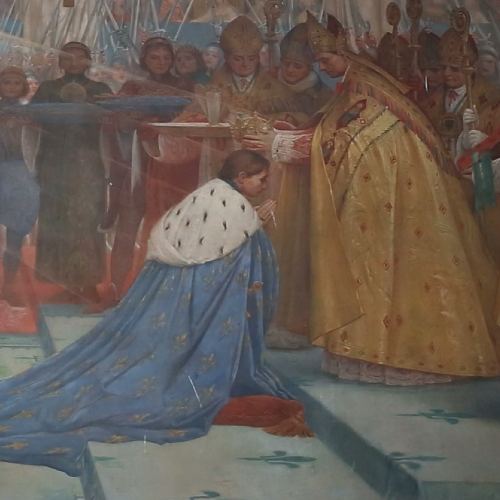 Crowning of the King
Crowning of the King
The crowning and consecration of the king were held in Reims upon her arrival. From the first Christian King Clovis I, all the kings had been consecrated. The king did not govern on his own authority, but as a man chosen by God, a delegate of Jesus Christ. Joan accompanied Charles in the consecration. It seemed to be a sort of “transfiguration” leading up to the Passion.
Betrayed by Her Own
The king began to ignore Joan and soon handed her over to the Burgundians, allies of the English. She had foretold her capture to those closest to her, painfully admitting that, “I will no longer be able to serve the king nor the kingdom of France.”
Capture and Imprisonment
She sought aid in the city of Compiegne. She went out to defend the city and someone shouted: “Retreat!” without her having said anything. All the troops turned back towards the bridge, but it closed before she could enter and she was taken prisoner.
She spent months in prison at the mercy of the Burgundians, who place her on trial in Rouen.
The Trial and Sentence
The trial began January 9, 1431 and was overseen by the University of Paris, presided by Bishop Chauchon. She was unaware as to why she was placed on trial, moreover by an ecclesiastical court.She was submitted to great pressure both in prison and during the trial, but through it all she proved herself capable of holding her own. Her voices foretold her martyrdom, counseling her, “Accept all things willingly and do not be afflicted for your martyrdom, for in the end you will enter the Kingdom of Heaven.” When her trial began and she was asked to swear an oath, she personally composed the following: “Concerning my father, my mother, and what I have done since I arrived in France, I will gladly swear; but concerning the revelations from God, I have never nor shall ever reveal them to anyone, save only to Charles, my King.”
Her answers were enlightening and her accusers found no explanation as to the keen reasoning of this young woman who could neither read nor write.
The trial records are a sort of “autobiography” that introduce us into St. Joan’s heart, a heart that the English claimed to be made of “iron,” as it stood firm in the midst of torments and strife.
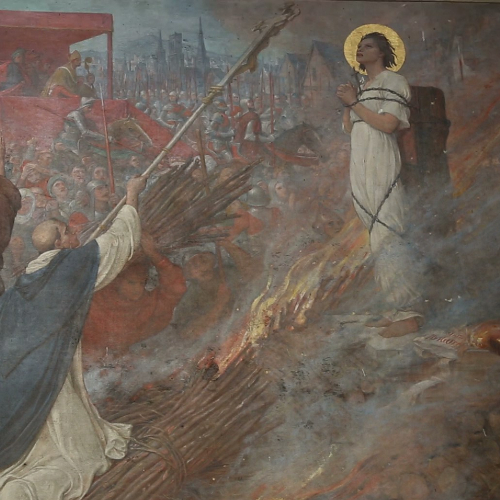 Sentence and Death
Sentence and Death
Joan’s sentence to death was decided prior to her trial. The accusation against her was that of witchcraft, in spite of the fact that no evidence could be found against the faith. Thus, her accusers sought other grounds for her indictment. They decided to stage her public repentance and later on, her supposed relapse into heresy. If convicted, the sentence was death by burning at the stake.
The morning of May 30, 1431 she entered the square bound hand and foot, wearing a tunic. She arrived in a prayerful silence. All those present wept and she begged forgiveness. Joan requested a cross, however no one had a cross to offer her. An Englishman moved by her words fashioned a cross out of wood from the stake, however Joan requested a bigger cross. “I ask that you bring me a cross from the nearest Church, to place before me until I die…that the cross God hung upon may be continually in my sight.” Her confessor went in search of a processional cross from the nearest church and that was the cross she had before her until the moment of her death.
Joan publicly ratified her divine mission at the stake and earned her the title of “martyr of the truth.” Her confessor testifies: “At the stake, in prison, in the face of death, and in the presence of the judges, she continued to sustain and affirm that her voices came from God, that all her works were done in obedience to the Lord, that she did not believe that she had been deceived by her voices, and that the revelations she had received came from God.” The name of Jesus was on her lips until the end. She shouted and invoked His name with such strength that it was heard throughout the entire square, which was crowded with onlookers: 800 soldiers and 5,000 civilians. A friar who witnessed the scene testified that, “at the end, at the moment of her death, she shouted one last time: ‘Jesus!’” Thus was the death of the Maid of Orleans.
Behold, Her Heart!
The testimony of Massieu relates a miraculous occurrence: “I heard from Jean Fleury, the clerk of the bailiff and town clerk, that the executioner had told him that when Joan’s body was burned and reduced to ashes, her heart remained intact and full of blood. The executioner was told to gather the ashes and all that was left of her and to throw them into the Seine, which he did.” Joan’s heart had remained incorrupt. We could say that this was yet another sign of her virginal heart, intact and dedicated to God alone.
Rehabilitation or Nullification
The rehabilitation or nullification process was opened on November 7, 1455 in the Cathedral of Paris. This trial was no less difficult. Restoring Joan’s good name was no easy feat, seeing as human pride still sought to taint and cast doubt on the truth. However, investigators found so much procedural irregularity in her trial at Rouen, that the decision was made to annul it completely, as if it had never taken place.
A Saint Without Altars
Her process of canonization was opened several centuries later in Orleans. Cardinal Pie was the first to speak openly of Joan. In 1844, he had no qualms in declaring that, “Joan is a contemplative warrior, of heaven and of earth. She is—forgive the anticipation—a weeping martyr, a saint without an altar to be venerated.” In 1869, Bishop Dupanloup of Orleans asked all the bishops of the cities through which la Pucelle had passed to sign a petition to Pope Pius IX requesting her canonization. Finally, in 1894, Leo XIII opened her cause, assigning her the title of Venerable. In his homily, he affirmed, “Joan is of our own. She is called to become a glowing flame not only in the heavenly Jerusalem, but also in the earthly Jerusalem.” It was Pope Pius X who signed the decree proclaiming her heroic virtue and opened a study of miracles attributed to the Venerable’s intercession. The long awaited beatification was held on April 18, 1909. Bishop Touchet oversaw her process up until the canonization, which took place on May 16, 1920. Two years later, she was proclaimed the second patroness of France.
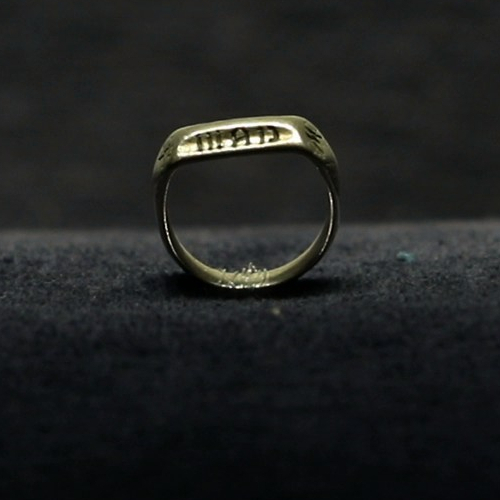 Virgin, Queen… and Martyr?
Virgin, Queen… and Martyr?
In her canonization, Joan is recognized as holy virgin, however she was also queen and martyr. The canonical grounds for identification of a martyr in hatred of the faith could also be applied to St. Joan. She died on account of hatred towards the divine message that she transmitted. She is martyr of the universal kingship of Christ, as well as of the sacred and divine character of the French monarchy.
The One Remaining Relic
Nothing was left of Joan’s body after her death, however Providence had it that one remaining relic was left behind: her ring. During the trial, she was questioned: “Do you have any rings?” to which she replied, “You have one that is mine. Return it.”
Joan’s ring ended up in England and 585 years later, the opportunity emerged for it to return to France. Jacques Tremolet de Villers, an expert on St. Joan of Arc, upon discovering that the ring would be put up for auction by “Timeline Auctions”, informed his friend, the founder of Puy du Fou Theme Park, who set everything in motion for its reclaiming. It is now conserved in a chapel in the park.





